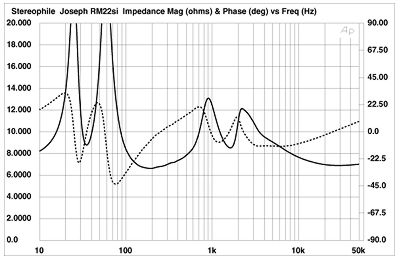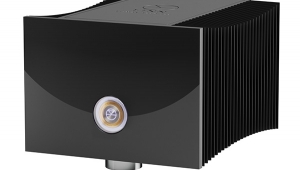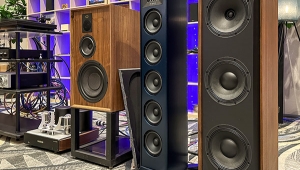| Columns Retired Columns & Blogs |
Joseph Audio RM22si Signature loudspeaker Measurements
Sidebar 3: Measurements
The neat floorstanding Joseph is not very sensitive, my B-weighted figure of 84.5dB/2.83V/m being below average. However, its impedance curve (fig.1) reveals it to be a generally kind amplifier load, its lowest value being a still reasonable 6.6 ohms in the lower mids. And though the electrical phase angle was quite capacitive in the upper bass, the magnitude was highish in the same region, which will ameliorate the current demands on the amplifier. The saddle between the twin bass peaks indicates that the port is tuned to a low 35Hz, implying good extension for a 6.5" woofer.

Fig.1 Joseph RM22si, electrical impedance (solid) and phase (dashed) (2 ohms/vertical div.).
There are slight wrinkles visible in the impedance traces between 200Hz and 500Hz, which generally indicate the presence of some kind of resonant behavior, usually in the cabinet panels. The RM22si's sand-damped cabinet appears to be exceptionally well braced, as plotting waterfall traces from the output of a PVDF-tape accelerometer revealed no significant cabinet panel vibrational modes. Fig.2, for example, shows the behavior of the side panel, 6" from the base—zilch to be seen!

Fig.2 Joseph RM22si, cumulative spectral-decay plot of accelerometer output fastened to cabinet sidewall 6" from base. (MLS driving voltage to speaker, 7.55V; measurement bandwidth, 2kHz.)
However, that tunnel-like port misbehaves, as can be seen in fig.3, which shows the individual outputs of the port, woofer, and tweeter. Strong peaks can be seen at 255Hz and 500Hz in the port response, these presumably due to "organ pipe" resonances of some kind. Yes, it's true that the position of the port, at the base of the cabinet's back panel, will minimize the audibility of these peaks, but I still don't like to see them. Moving higher in frequency, the woofer shows a slight rising trend, with some mild peakiness evident in the upper midrange before the Infinite Slope low-pass filter rolls it off at a tremendous rate. Two what I assume are woofer cone-breakup modes can just be seen at 5kHz and 7kHz, but these are well suppressed by the crossover and will have no subjective consequences. The tweeter's output below the 2kHz crossover point is also well suppressed, and its output is flat within its passband.

Fig.3 Joseph RM22si, acoustic crossover on tweeter axis at 50", corrected for microphone response, with nearfield woofer and port responses plotted below 300Hz and 1kHz, respectively.
Fig.4 shows how these individual responses add up on the tweeter axis at a 50" distance. Note the speaker's excellent bass extension from this graph: -6dB at 33Hz! While the speaker's balance trend is basically flat, there is a slight energy excess in the upper midrange, at the top of the woofer's passband. Alternatively, the presence region could be regarded as being slightly laidback by contrast with the upper mids. Whether or not the listener detects and finds it bothersome will depend on the type of music being played on the Josephs.

Fig.4 Joseph RM22si, anechoic response on tweeter axis at 50", averaged across 30 degrees horizontal window and corrected for microphone response, with complex sum of the nearfield woofer and midrange responses plotted below 300Hz.
- Log in or register to post comments




































